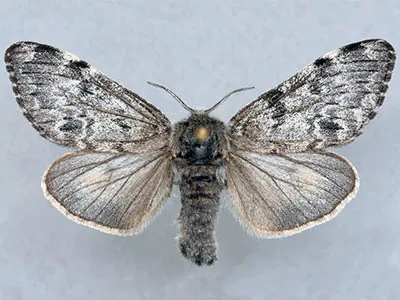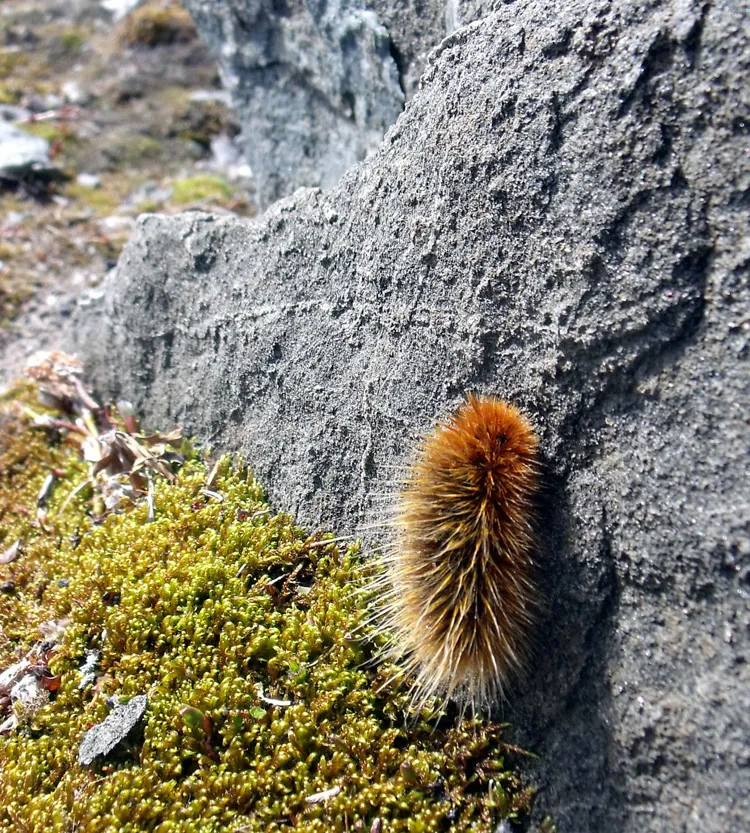Arctic Woolly Bear Moth
Facts and Adaptations
Gynaephora groenlandica
A small moth that lives at the edge of what is possible, as a caterpillar it lives a stop-go life taking around seven years to build up enough resources to finally pupate into the adult moth.
Arctic Woolly Bear Moth facts
Basics

Breeding Season: A two week period in
the warm (er) days of late spring and early summer when
the non-feeding adults emerge, mate, lay their eggs and
die.
Feeding & diet: A whole
range of plant foods, with such short activity periods,
they can't waste time walking around looking for that "just
right" plant. They usually start off by eating the
nearest plant when they hatch from the egg, they have a
preference for young more nutritious and easy to chew leaves
before they start to develop tannins. The adults don't
feed at all in common with many moth species.
Distribution: Northern Canada on the mainland
and northern islands, also found on Greenland.
Predators: Around 75% of all caterpillars
are killed by 2 species of parasitoid wasps and a species
of fly.
What are Arctic Wooly Bear Moths like? how do they survive?
The Arctic Woolly Bear Moth is fairly non-descript looking small drab moth. It lives its whole life in the far north of the Arctic on the mainland and northern islands of Canada and around the vegetated coastal strip of Greenland.
It is notable for living a stop-go life whereby the caterpillar takes around seven years to build up enough resources to finally pupate into the adult moth. It was previously thought to take fourteen years to do this, though revised estimates now make seven a typical though not absolute length of time reference.
As a small terrestrial invertebrate the moth has a major problem to deal with in that it is frequently too cold for it to be active. Before it can become active it needs to reach a warm enough temperature for the chemical processes in its cells to enable it to move around and feed, this happens when they get to 15°C-30°C. This temperature is one that is often just not possible for the caterpillar to achieve for the majority of the year, so most of the time it just sits and waits......
This aspect of the lifestyle alone is not actually so unusual, there are other insects that spend several years as a larva and just a few weeks or months as an adult. Dragonflies can spend up to five years as an aquatic larva before emerging while some cicada species can go for thirteen or seventeen years at the larval stage. There are also many other polar invertebrates that have a stop-go lifestyle dependent on the temperature.
Arctic woolly bear caterpillars spend most of their lives actually frozen just thawing out for a short time in the summer.
Only the caterpillar is resistant to freezing, they pupate in their final summer in just two weeks and then the adult moth dies after a short summer of finding a mate and laying eggs. The eggs then hatch quickly so that the cold resistant caterpillars can overwinter. Like many other adult flying insects, the adult moths don't feed at all.
Over its lifetime, they will freeze and thaw seven times (typically).
 Arctic
wooly bear moth caterpillar, basking in the sun on a rock. Rocks
warm up more quickly and effectively than surrounding soil or
vegetation so they make a much better place to warm up to become
active. In such conditions the caterpillar can reach a temperature
of 20°C above ambient, especially if there is snow or ice
nearby to reflect more sunlight.
Arctic
wooly bear moth caterpillar, basking in the sun on a rock. Rocks
warm up more quickly and effectively than surrounding soil or
vegetation so they make a much better place to warm up to become
active. In such conditions the caterpillar can reach a temperature
of 20°C above ambient, especially if there is snow or ice
nearby to reflect more sunlight.
What is notable about the Arctic Woolly Bear Moth is the difficulty of the environment that it faces along with it's range of adaptations:
Arctic Wooly Bear Moth Adaptations:
- Basking to warm up (behavioural) -
The caterpillars spend up to 60% of their time while active
basking in the sunlight to reach a temperature where they
can feed and grow. This happens mainly around midday when
the caterpillars can reach a temperature of up to 30°C,
around 20°C above the surrounding air temperature in
ideal conditions. They usually also bask after feeding before
feeding again or moving onto a new site.
reference They spend around 5% of their lives actually
feeding almost entirely during the month of June.
- Most of their life is spent in hibernation in
a hibernaculum (behavioural) - A hibernaculum is
a light silk overwintering structure not as dense or complete
as a cocoon that the caterpillar spins prior to its
eleven month dormancy. The caterpillars spend about 90%
of their life hidden away usually amongst rocks, this gives
them protection from the parasites that are responsible
for the deaths of around 75% of the caterpillars. For much
of this time, they are actually frozen. Being surrounded
by cold rocks means that their temperature is more stable
than the surrounding soil, so they don't suffer so much
from the potentially harmful effects of cycles of thaw and
freezing without becoming warm enough to become active.
In the spring, rocks may also absorb heat better than vegetation
so speeding up snow melt and allowing early emergence.
reference
- A covering of hairs or setae that conserve heat
(anatomical) - The source of the Woolly Bear caterpillars
name is also one of its adaptations to living in a harsh
environment. Once warmed up by basking, the hairs help to
retain the heat so allowing the caterpillar to remain active
for longer and also to allow its metabolic processes such
as digestion to take place more efficiently.
- The production of cryoprotectants in the blood and body tissues (physiological) - This is a vital part of the cold adaptations that allow this cold blooded creature to survive even though it may be frozen solid down to -70°C. There are a number of different chemicals that the caterpillar produces to this end such as glycerol and others that are more exotic. An aspect of the production of these chemicals is that it results from the breakdown of the mitochondria in the cells, these are then re-synthesized again the following year when the caterpillars become active again.
Copyright pictures used by permission: Creative Commons Attribution 2.0 license - caterpillar Gynaephora groenlandica, Mike Beauregard
